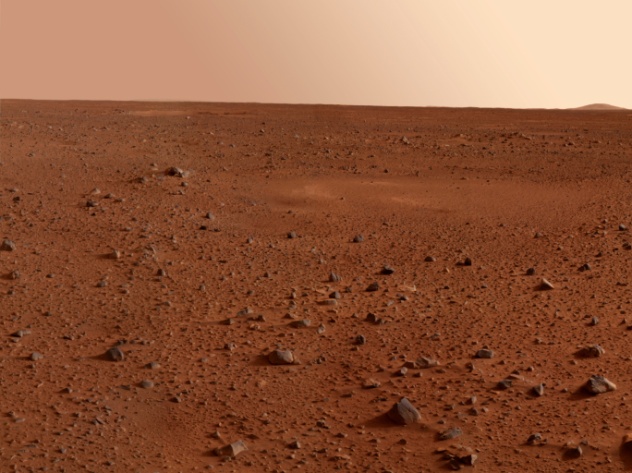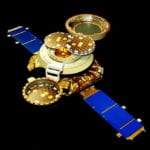 Technology
Technology  Technology
Technology  Humans
Humans 10 Everyday Human Behaviors That Are Actually Survival Instincts
 Animals
Animals 10 Animals That Humiliated and Harmed Historical Leaders
 History
History 10 Most Influential Protests in Modern History
 Creepy
Creepy 10 More Representations of Death from Myth, Legend, and Folktale
 Technology
Technology 10 Scientific Breakthroughs of 2025 That’ll Change Everything
 Our World
Our World 10 Ways Icelandic Culture Makes Other Countries Look Boring
 Misconceptions
Misconceptions 10 Common Misconceptions About the Victorian Era
 Mysteries
Mysteries 10 Strange Unexplained Mysteries of 2025
 Miscellaneous
Miscellaneous 10 of History’s Most Bell-Ringing Finishing Moves
 Technology
Technology Top 10 Everyday Tech Buzzwords That Hide a Darker Past
 Humans
Humans 10 Everyday Human Behaviors That Are Actually Survival Instincts
 Animals
Animals 10 Animals That Humiliated and Harmed Historical Leaders
Who's Behind Listverse?

Jamie Frater
Head Editor
Jamie founded Listverse due to an insatiable desire to share fascinating, obscure, and bizarre facts. He has been a guest speaker on numerous national radio and television stations and is a five time published author.
More About Us History
History 10 Most Influential Protests in Modern History
 Creepy
Creepy 10 More Representations of Death from Myth, Legend, and Folktale
 Technology
Technology 10 Scientific Breakthroughs of 2025 That’ll Change Everything
 Our World
Our World 10 Ways Icelandic Culture Makes Other Countries Look Boring
 Misconceptions
Misconceptions 10 Common Misconceptions About the Victorian Era
 Mysteries
Mysteries 10 Strange Unexplained Mysteries of 2025
 Miscellaneous
Miscellaneous 10 of History’s Most Bell-Ringing Finishing Moves
10 Proposed Solutions To The Problems Of Interstellar Travel
Right now, interstellar travel and colonization is pretty unlikely. Basic laws of physics suggest that it just can’t be done, and for many people, that means it’ll never be done. Those people are no fun. Others are more idealistic, looking for ways to break the laws of physics (or at least find a loophole) that will allow us to travel to distant stars and explore whole new worlds.
10 Alcubierre Warp Drive
Anything called a “warp drive” might sound like it’s more at home on Star Trek than in NASA. Nevertheless, the Alcubierre Warp Drive is an idea that they’re kicking around as a possible solution (or at least the beginning of a solution) to overcoming the universe’s restrictions when it comes to moving faster than light.
The basics of the idea are pretty simple, and NASA uses the example of a moving walkway to explain it. While a person can only walk so fast on a moving walkway, the combined speed of the person and the walkway mean that they get to the end faster than they would on their own. The walkway is the warp drive, moving along space-time within a sort of bubble of expansion. In front of the warp drive, space-time is contracted. Behind it, it’s expanded. This should, in theory, allow the drive to move whatever is in it faster than the speed of light. One of the key principles, that of expanding space-time, has already been explored as what allowed the universe to expand so fast in the moments after the Big Bang. Therefore, in theory, doing so should be feasible.
More complicated is creating the warp drive itself, which NASA says would require a massive pocket of negative energy around the craft. They’re not sure whether or not that’s even possible. (Their final answer on the subject was a resounding, “I don’t know . . . maybe?”) Furthermore, manipulating space-time forces you into even trickier questions about time travel, powering the negative energy bubble, and how to turn it on and off.
The idea was the brainchild of physicist Miguel Alcubierre, who also explained the warp drive’s abilities as somewhat like skipping across waves in space-time rather than taking the long way. Technically, it wouldn’t break the laws of faster-than-light travel, and he’s even done the math to support the theory.
9 The Interstellar Internet
It’s bad enough when you’re lost on Earth and can’t get Google Maps to load on your smartphone. Interstellar travel would be worse, presenting all kinds of other communications issues. Getting out there is only the first step, and scientists are looking at just what’s going to happen when our manned and unmanned probes need a way to get a message back to Earth.
In 2008, NASA conducted the first successful tests on an interstellar version of the Internet. The project started in 1998 as a partnership between NASA’s Jet Propulsion Laboratory (JPL) and Google. Ten years later, they had something called the Disruption-Tolerant Networking (DTN) system, which allowed them to send images to a spacecraft 20 million miles away.
The technology needed to be able to handle long delays and disruptions in transmissions, so it can continue transit even when the signal is broken for up to 20 minutes. It can get through, around, or past everything from solar flares and solar storms to pesky planets that get in the way of transmission without losing any of the information it’s sending.
According to Vint Cerf, one of the founders of our Earthbound Internet and pioneer of an interstellar one, the DTN system overcomes all of the problems that the traditional TCIP/IP protocol has when it’s dealing with the distances involved in interplanetary travel. With TCIP/IP, doing a Google search on Mars would likely take so long that the results would have changed by the time they got back, and they’d most likely only be a garbled bunch of broken information packets, anyway. With DTN, they’ve added something pretty wild—the capability to assign different domain names to different planets and to choose which planet you want to route your Internet searches and traffic to.
So what about going beyond the planets that we’re already familiar with? Scientific American suggests that there might be a way, albeit a hugely expensive, time-consuming way, to create an Internet that reaches all the way to Alpha Centauri. By launching a series of self-replicating von Neumann probes (more on that later), a long string of relay stations can be created, which can send information along what would essentially be an interstellar chain letter. The signal perfected in our own system would bounce between the probes and finally back to Earth or, depending on the direction, to Alpha Centauri. Granted, that’s going to take a lot of probes, each costing billions to build and launch. Of course, given that the most distant of the probes wouldn’t reach its target for thousands of years, we’d have time to save money and, presumably, improve the technology, lowering the price.
8 Embryo Space Colonization

One of the big problems with interstellar travel, and ultimately colonization, is the sheer amount of time that it’s going to take us to get anywhere, even with nifty toys like proposed warp drives. Just how to get a group of settlers to their destination presents a whole new set of issues, and one of the proposed plans for creating an able group of settlers is to send off not fully crewed ships, but rather seed ships bearing embryos. Once the ship reaches an appropriate distance from its destination, the frozen embryos will begin to be grown. Eventually, they turn into children who are raised on the ship, and when they finally reach their destination, they’re capable of settling a new civilization.
This, of course, has a whole other set of issues attached to it, like who or what is going to do the raising. Robots might be used to raise the children, which poses some fascinating questions about what humans raised entirely by robots would be like. Could robots understand what a child needs to grow and thrive? Could they understand punishments, rewards, and human emotion? Also, the whole idea assumes that we figure out how to preserve undamaged frozen embryos for hundreds of years and how to grow them in an artificial environment. We have, however, managed that with sharks, so we might not be too far behind in the grand scheme of things.
One proposed solution that would bypass the so-called robot nanny problem is to create a combination of a seed ship and a sleeper ship, where adults are kept in a sort of suspended animation, woken up when they’re needed to help raise the children born from the seed ship. A series of child-raising years punctuated with a return to hibernation could, in theory, result in a stable population. A carefully established batch of embryos would ensure enough genetic diversity to keep the population going in a more or less normal way after a new colony is established. An additional batch of embryos would also be included in the seed ship, which would be in turn used to impregnate the colony’s first generation of women, further diversifying the gene pool.
7 Self-Replicating Spacecraft
Anything that we build and send out into space is obviously going to have its problems, and making things that need to last for millions of miles without burning out or breaking down seems like a pretty impossible obstacle, but the answer might have been stumbled upon decades ago. In the 1940s, physicist John von Neumann proposed a mechanical technology that could replicate itself, and while he didn’t apply the idea to interstellar travel, those after him started to look that way. The resulting von Neumann probes could, in theory, be used to explore vast, interstellar territories. According to some researchers, the idea that we’re the first to think of this idea is not only rather pompous of us, but it’s pretty unlikely, too.
University of Edinburgh researchers published findings in the International Journal of Astrobiology, exploring not how we might use this blossoming technology for our own exploration, but rather the likelihood that someone else has already been doing exactly that. Building on previous calculations that estimated how far craft could get using different types of travel, the researchers looked at how the equation would change if it was applied to self-replicating craft and probes.
They based their calculations around self-replicating probes that could use debris and other material in space to build what they called child probes. These parent and child probes would multiply into a large enough number that they would be able to cover the entirety of our galaxy within about 10 million years—and that’s if they were only traveling at about 10 percent the speed of light. In turn, that means it’s incredibly likely that at some point, we would have been visited by some kind of self-replicating probes. Since we don’t think we have, they say there are only two explanations: We’re not technologically advanced enough to know what we’re looking at, or we really are alone in the galaxy.
6 Black Hole Slingshots
The idea of using a planet or moon’s gravity to sort of slingshot around it has been used more than once within our own solar system, most notably by Voyager 2, which got an extra push from first Saturn and then Uranus on its way out of the system. The idea involves maneuvering a craft to get an increase (or decrease) in speed as it navigates through a planet’s gravitational field. The basic idea has also been a favorite in science fiction works.
Writer Kip Thorne put forward the idea that doing something similar might help craft cut down on one of the big challenges when it comes to interstellar travel—fuel consumption. He suggested something a little more risky, however, namely maneuvering around a set of binary black holes. Only a minute amount of fuel would actually be needed to ride the critical orbit from one black hole to the other. When the craft in question has made several circuits between the two black holes, its speed would be approaching the speed of light with minimal fuel consumption. Then, it would just be a matter of aiming correctly and firing a rocket thrust at the right instant to set off on a course across the stars.
Is this idea unlikely? Absolutely. Is it kind of awesome? Certainly. Thorne stresses that there are a lot of problems with his idea, like the precise calculations and timing that would be needed to make sure you didn’t end up flying straight through another star, planet, or other inconveniently placed interstellar body. There are also concerns such as slowing down, stopping, and getting home again, but we’re pretty certain that if you’re willing to do this in the first place, you might not be too concerned about getting home again.
A precedent for the idea has already been set. In 2000, astronomers got a look at 13 supernovae speeding along through the galaxy at a mind-blowing 5 million miles per hour. University of Illinois at Urbana-Champaign researchers figured out that the wayward stars were flung out of their galaxy by a pair of black holes trapped in an orbit around each other after the destruction and merging of two separate galaxies.
5 Starseed Launcher

When it comes to launching even self-replicating probes, there’s still the problem of fuel consumption. That hasn’t stopped people from trying to come up with new ideas on how to launch probes across interstellar distances, a process that would require megatons of energy with the technology we have today.
Forrest Bishop of the Institute of Atomic-Scale Engineering claimed to have created a method for launching interstellar probes that only requires an amount of energy roughly equivalent to what’s in a car battery. The theoretical Starseed Launcher would be about 1,000 kilometers (600 mi) long and consist mainly of wire. In spite of its length, the whole thing would fit onto a shuttle when stored and could be charged by a 10-volt battery.
Part of the plan involved launching probes that are little more than micrograms in mass, containing only the most basic information needed to build further probes in space. Groups of up to billions of these probes could be launched by a series of launchers. Bishop said his plan is easier because the self-replicating probes can join up with each other after launch. While he had plans for the launcher itself to be powered by superconducting magnetic levitation coils, creating an opposing force that provides the power, he said that there are still some things that need to be worked out before it can be practically built, like how the probes would weather hazards like interstellar radiation and debris.
4 Engineering Plants To Live In Space

Once we get where we’re going (or once we get on our way), there needs to be some sort of method for growing food and regenerating oxygen. Physicist Freeman Dyson has some pretty intriguing ideas on exactly how we can do that.
In 1972, Dyson gave his rather infamous lecture at London’s Birkbeck College. There, he suggested that with some genetic manipulation, trees could be developed that would be able to not only grow, but thrive on surfaces as inhospitable as a comet. Reprogram the tree to reflect ultraviolet light and to be more efficient at retaining water, and not only would trees take root and grow, but they’d grow to sizes unimaginable on Earth. In one interview, he suggested that there might be black trees in the future, both in space and on Earth. Silicon-based trees and leaves would be much more efficient, and efficiency is the key to continued survival. Dyson stressed that this certainly wouldn’t be an overnight process and would probably take well into the next two centuries before we have the technology and knowledge to manipulate plants in such a way.
His idea might not be too far-fetched. NASA’s Institute for Advanced Concepts is an entire division dedicated to solving the future’s problems, and one of the things that they’re working on is growing plants suitable for the landscape of Mars. Even plants grown in a greenhouse or similar building on Mars would be subjected to extremes, and researchers are working with the idea of combining plants with extremophiles, tiny, microscopic organisms that survive in the harshest places on Earth. From high-altitude tomato plants that have a built-in resistance to ultraviolet light to bacteria that survives in the coldest, hottest, and deepest parts of the world, we might already have the building blocks to create Martian gardens. We just need to figure out how to put them all together.
3 In-Situ Resource Utilization
Living off the land might be the hip and trendy new thing on Earth, but when it comes to months-long missions in space, it’s going to be a necessity. NASA is currently exploring what they call In-Situ Resource Utilization, or ISRU. There’s only so much room on a ship, after all, and establishing systems for using materials found in space and on other planets is going to be a necessity for any long-term colonization plans or trips, especially when those trips mean going to places where resupply missions are simply out of the question. Early attempts at demonstrating just how resource usage would work took place on the slopes of Hawaii’s volcanoes and in simulations of polar missions to the Moon, involving attempts to extract things like fuel components from ash and other naturally occurring terrain.
In August 2014, NASA made a massive announcement when they revealed what new toys were going to be outfitting the next Mars rover, slated to launch in 2020. Included in the new rover’s arsenal is MOXIE, the Mars Oxygen In-Situ Resources Utilization Experiment. Like its name suggests, MOXIE will be capable of taking the noxious Mars atmosphere (which is about 96 percent carbon dioxide) and separating it into oxygen and carbon monoxide. It will be capable of producing about 22 grams of oxygen each hour that it’s running. NASA is also hoping that MOXIE will demonstrate something else—continuous operation without a decline in productivity or efficiency. They’re suggesting that not only is MOXIE a major step toward long-term extraterrestrial missions, but also that it’s the first of many potential converters that could act in a similar way to isolate different gases and other resources.
2 2suit
Reproduction in space is a problem on a number of different levels, especially in environments without artificial gravity. In 2009, Japanese experiments on mouse embryos proved that even though zero-gravity environments don’t hinder fertilization, embryos that develop outside Earth’s natural gravitational pull (or some equivalent) don’t develop normally. When the cells must divide and specialize, there are problems. This is not to say that it can’t be done, however, as some of the space-grown embryos were ultimately successfully implanted into female mice and were born normally.
This also brings up another question: Just how does actual baby-making work in a zero-gravity environment? The laws of physics, specifically the fact that every action has an equal and opposite reaction, make the mechanics more than a little sketchy. However, writer, actress, and inventor Vanna Bonta has put some serious thought into it.
The result is the 2suit, and it’s exactly what you think it is—a space suit designed to have two people zipped inside of it in order to facilitate the making of space babies. It’s actually been tested, too. In 2008, it was used on the aptly (though unromantically) named Vomit Comet. While Bonta suggests that honeymoons in space might become an actual thing thanks to her invention, she also says that it has other practical applications, like conserving body heat during an emergency.
1 Project Longshot

Project Longshot was a perhaps cynically named plan drawn up by a team from the US Naval Academy and NASA as a part of a joint project in the late 1980s. The plan had the ultimate goal of launching sometime around the turn of the 21st century, and it would have been an unmanned probe destined for Alpha Centauri. It would have taken about 100 years to reach its goal. Before it could even be launched, there were some pretty key components that needed to be developed before it would ever get off the ground.
Between communications lasers, a long-life fission reactor, and a fusion microexplosion drive, there was a lot that needed to come together. The probe was going to be designed to think and function independently, as it was next to impossible to send communications over interstellar distances quickly enough that the information would still be relevant when it was received. Everything would have to be incredibly durable, as it was going to be 100 years before it even reached its destination.
Longshot was going to travel to Alpha Centauri with several different objectives. Mainly, it was going to be collecting astronomical data that would have allowed for the precise calculation of the distances to billions, if not trillions, of other stars. Run off its nuclear plant until the reaction, and therefore the mission, stopped, Longshot was a pretty ambitious plan that never got off the ground.
That doesn’t mean that the idea’s completely gone, though. In 2013, Project Longshot II was figuratively getting off the ground in the form of a student project from Icarus Interstellar. The decades of technological advancements that have happened since the original Longshot program can be applied to the new version, and the program will be getting a complete overhaul. Among the advancements made to the program will be cutting the projected flight time in half, recalculating fuel costs, and taking a look at redesigning Longshot from top to bottom.
The final project will be an interesting look at how an insurmountable problem changes with the addition of new technology and new information. The laws of physics remain the same, but 25 years later, Longshot has the potential to look pretty different, and that’s an intriguing notion for the future of interstellar travel.








